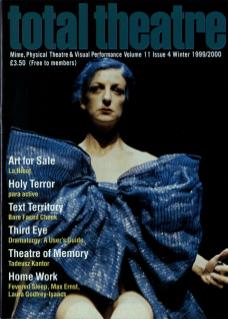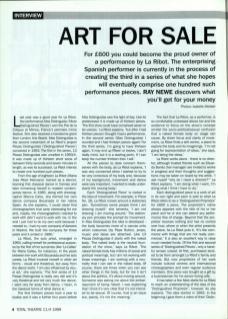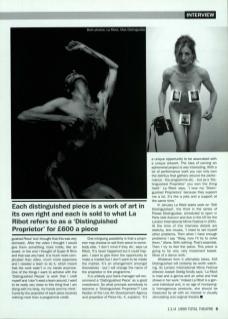Last year was a good year for La Ribot. Her performance Mas Distinguidas ('More Distinguished Pieces') won the Prix de la Critique at Mimos, France's premiere mime festival. She also received a handsome grant from London Arts Board. Mas Distinguidas is the second instalment of La Ribot's project Piezas Distinguidas (‘Distinguished Pieces') conceived in 1993. The first in the series, 13 Piezas Distinguidas was unveiled in 1993/4. It was made up of thirteen short solos of between thirty seconds and seven minutes in length, as was its successor. La Ribot intends to create one hundred such pieces.
From the age of eighteen La Ribot (Maria Jose Ribot Manzano) trained as a dancer, learning first classical dance in Cannes and later immersing herself in modern contemporary dance. In 1985, along with choreographer Blanca Calvo, she formed her own dance company Bocanada in her native Spain. As she explains, 'I could never find choreographers that were interesting for me and, maybe, the choreographers I wanted to work with didn't want to work with me. In the end I just had to do my own work because I needed to. I had my own company of dancers in Madrid. We built the company for three years and it ended in 1990.
La Ribot, the solo artist, emerged in 1993, calling herself for professional purposes by the first of her surnames (like 'La Callas' for Maria Callas, for instance). In the years between her work with Bocanada and her solo career, La Ribot involved herself in other art forms – visual and theatrical, but away from the dance world. 'I am very influenced by visual art,' she explains. ‘The first series of 13 Piezas Distinguidas is really very still and it's very theatrical and not very much like dance. I went very far away from dance, I mean, in the classical terms of what dance is.’
The first thirteen pieces took a year to realise and it was a further four years before Mas Distinguidas saw the light of day. Like its predecessor it is made up of thirteen pieces. ‘The first show could have comprised seven or ten pieces,' La Ribot explains, 'but after I had thirteen pieces I thought I had a performance. In the second series [Mas Distinguidas] I counted and I had thirteen pieces again! For the third series, I'm going to have thirteen again. It may end up fifteen or twelve, I don't really mind, but it is a starting point. If I can keep the number thirteen then I will.’
All the pieces to date concern themselves with the body, as La Ribot explains, 'I was very concerned when I started to try to be very conscious of my body and, because of my background, movement and dance were very important. I wanted to really understand the moving body.'
Each 'Distinguished Piece’ is rooted in the idea of movement. For example, in Piece No. 26, La Ribot moves around a stationary pen. 'Sometimes some people think I am drawing myself,' she laments, 'I am not drawing: I am moving around. The stationary pen provides the prompt for movement. In Mas Distinguidas the idea is developed – the body becomes more of a canvas onto which costumes (by Pepe Rubio), props, music and ideas are attached. Like 13 Piezas Distinguidas it starts with the naked body. ‘The naked body is the neutral foundation of the show,' says La Ribot. 'The naked female body has millions of social and political meanings, but I am not working with those meanings. I am working with a neutrality that I can see in the naked body. Of course, there are times when you can see other things in the body, but for me it isn't about the politics, it's about moving around. Someone was asking me about the embarrassment of being naked. I was explaining that I think it's very clear that it's not intended to be sexual. Of course, that is an issue but, plainly, it's not the meaning.’
Each distinguished piece is a work of art in its own right and each is sold to what La Ribot refers to as a 'Distinguished Proprietor' for £600 a piece
The fact that La Ribot, as a performer, is so comfortable undressed allows her and the audience to focus on the show's concept amidst the socio-political/sexual confusion that a naked female body on stage can cause. By sheer focus and clarity of movement, La Ribot finds a still centre, a place to explore the body and its imaginings. ‘I'm not going for representation of ideas,' she says. 'I am being the ideas.’
La Ribot works alone – there is no director, although trusted friends such as Eduardo Bonito (her manager) are invited to works in progress and their thoughts and suggestions may be taken on board by the artist. ‘I ask myself "why do I need a director?"’ La Ribot explains. 'I am doing what I want, I'm doing what I think I have to do.’
Each distinguished piece is a work of art in its own right and each is sold to what La Ribot refers to as a 'Distinguished Proprietor’ for £600 a piece. The proprietor's name always appears with the title of his or her piece and he or she can attend any performance free of charge. Beyond that the proprietor receives nothing and has no control over how, where or when the artist presents the piece. As La Ribot puts it, 'It's like commerce with things that are not really commercial.’ It is also an excellent way to raise much-needed funds. Of the first and second series of ‘Distinguished Pieces' only a handful remain unsold. At first, purchasers tended to be from amongst La Ribot's family and friends. But now proprietors of her work include cultural centres and international choreographers and even regular audience members. One piece was bought as a gift by a businessman for his dance-loving wife.
It has taken a few false starts for La Ribot to reach an understanding of the idea of the ‘Distinguished Proprietor’, however. As she explains, 'The idea started in 1993. In the beginning I gave them a video of their “Distinguished Piece” but I thought that this was very domestic. After the video I thought I would give them something more noble, like an award. In the end I thought of Super 8 films and that was very hard. It is much more complicated than video, much more expensive, and I needed a team to do it, which meant that the work wasn't in my hands anymore. One of the things I want to achieve with the “Distinguished Pieces” is work that I craft myself and I don't need a team around. I want to be really very close to this thing that I am doing with my body, my hands and my mind.' Currently the proprietor of each piece receives nothing more than a programme credit.
One intriguing possibility is that a proprietor may choose to sell their piece to somebody else. ‘I don't mind if they do,' says La Ribot. 'It's never happened but it could happen. I want to give them the opportunity to make a market but I don't want to be inside the market. It's an arrangement amongst themselves – but I will change the name of the proprietor in the programme.’
It is unlikely your bank manager will recommend a 'Distinguished Piece' as a good investment. So what prompts somebody to become a 'Distinguished Proprietor'? Lois Keidan of the Live Art Development Agency and proprietor of Piece No. 4, explains: ‘It's a unique opportunity to be associated with a unique artwork. The idea of owning an ephemeral project is very interesting. With a lot of performance work you can only own the detritus that gathers around the performance – the programme, etc – but as a “Distinguished Proprietor” you own the thing itself.' La Ribot says, 'I love my “Distinguished Proprietors” because they support me a lot. It's like a joke and a support at the same time.'
In January, La Ribot starts work on Still Distinguished, the third in the series of Piezas Distinguidas, scheduled to open in Paris next Autumn and due in the UK for the London International Mime Festival in 2001. At the time of this interview details are sketchy, she muses, 'I need to set myself other problems. Then when I have enough problems I say "Okay, now I'll try to solve them." Alone. With nothing. That's essential. Then I try to feel the piece. This piece is going to be very, very movement based. More of a dance work.’
Whatever form it ultimately takes, Still Distinguished will certainly be worth watching. As London International Mime Festival director Joseph Seelig fondly says: 'La Ribot is mad and a genius and an artist and that shows in her work.’ Indeed La Ribot is a genuine individual and, in an age of increasingly homogeneous products, she should be treasured by all with an interest in visually stimulating and original theatre.


